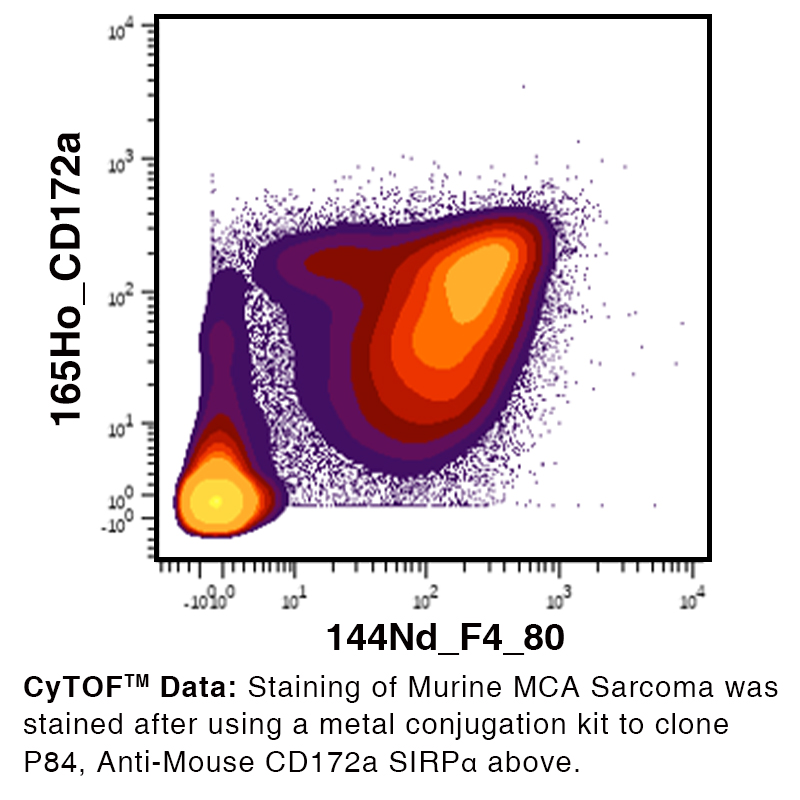Anti-Mouse CD172a [P84] – PE
Anti-Mouse CD172a [P84] – PE
Product No.: P386
- -
- -
Clone P84 Target CD172a Formats AvailableView All Product Type Monoclonal Antibody Alternate Names SHPS-1, BIT, P84, PTPNS1, CD172 antigen-like family member A Isotype Rat IgG1 κ Applications FC |
Data
- -
- -
Antibody DetailsProduct DetailsReactive Species Mouse Host Species Rat Recommended Isotype Controls Immunogen Mouse brain membrane protein Product Concentration 0.2 mg/ml Formulation This R-phycoerythrin (R-PE) conjugate is formulated in 0.01 M phosphate buffered saline (150 mM NaCl) PBS pH 7.4, 1% BSA and 0.09% sodium azide as a preservative. Storage and Handling This R-phycoerythrin (R-PE) conjugate is stable when stored at 2-8°C. Do not freeze. Country of Origin USA Shipping Next Day 2-8°C Excitation Laser Blue Laser (488 nm) and/or Green Laser (532 nm)/Yellow-Green Laser (561 nm) RRIDAB_2892951 Applications and Recommended Usage? Quality Tested by Leinco FC The suggested concentration for this P84 antibody for staining cells in flow cytometry is ≤ 0.25 μg per 106 cells in a volume of 100 μl. Titration of the reagent is recommended for optimal performance for each application. Additional Reported Applications For Relevant Conjugates ? CyTOF® IHC FF IP B Each investigator should determine their own optimal working dilution for specific applications. See directions on lot specific datasheets, as information may periodically change. DescriptionDescriptionSpecificity Clone P84 recognizes an epitope on mouse CD172a. Background CD172a antibody, clone P84, recognizes CD172a, also known as single regulatory protein α (SIRPα) (signal regulatory protein alpha) or Src homology 2 domain-containing phosphatase substrate-1 (SHP-1), a type I transmembrane glycoprotein with three Ig-like extracellular domains and two cytoplasmic immunoreceptor tyrosine-based inhibition motifs (ITIMs)1. SIRPα is expressed predominantly in myeloid cells2 - including monocytes, macrophages, and dendritic cells (DCs) - and neuronal cells3. The extracellular ligand for SIRPα, CD47 (or integrin-associated protein [IAP])4, is expressed in most cell types5. In macrophages, ligation of SIRPα by CD47 inhibits macrophage phagocytosis of self cells6,7. SIRPα also negatively regulates DC-mediated T cell activation and DC maturation8-10. CD47 is also upregulated on tumor cells, inhibiting the phagocytosis of tumor cells by macrophages11. Therapeutics targeting the CD47-SIRPα interaction, including antibodies and fusion proteins, are currently under preclinical and clinical study for various malignancies as a monotherapy or in combination with other therapeutics12. Antigen Distribution CD172a is expressed on monocytes, macrophages, dendritic cells, and neuronal cells. Ligand/Receptor CD47, SP-A, SP-D Function Negative regulation of several biological processes NCBI Gene Bank ID UniProt.org Research Area Cell Adhesion . Innate Immunity . Neuroscience References & Citations1. Fujioka, Y., et al. (1996) Mol. Cell. Biol. 16:6887 2. Adams, S., et al. (1998) J. Immunol. 161:1853 3. Chuang W, et al. (1990) Dev Biol. 137:219–232 4. Seiffert, M., et al. (1999) Blood 94:3633 5. Oldenborg P. A. (2013) ISRN Hematol. 2013:614619 6. Oldenborg, P. A., et al. (2000) Science 288:2051 7. Oldenborg, P. A., et al. (2001) J. Exp. Med. 193:855 8. Brooke, G. P., et al. (1998) Eur. J. Immunol. 28:1 9. Seiffert, M., et al. (2001) Blood 97:2741 10. Latour, S., et al. (2001) J. Immunol. 167:2547 11. Jaiswal S, et al. (2009) Cell. 138(2):271-85 12. Jalil AR, et al. (2020) Antib Ther. 3(2):80-94 Technical ProtocolsCertificate of Analysis |
Related Products
- -
- -
Prod No. | Description |
|---|---|
S211 | |
R1364 | |
I-1195 | |
C247 | |
F1175 | |
R1214 | |
S571 |
Formats Available
- -
- -
Prod No. | Description |
|---|---|
P386 | |
P387 | |
P380 | |
P390 | |
P391 | |
P392 | |
P385 | |
P389 | |
P388 | |
P680 | |
S200 |



